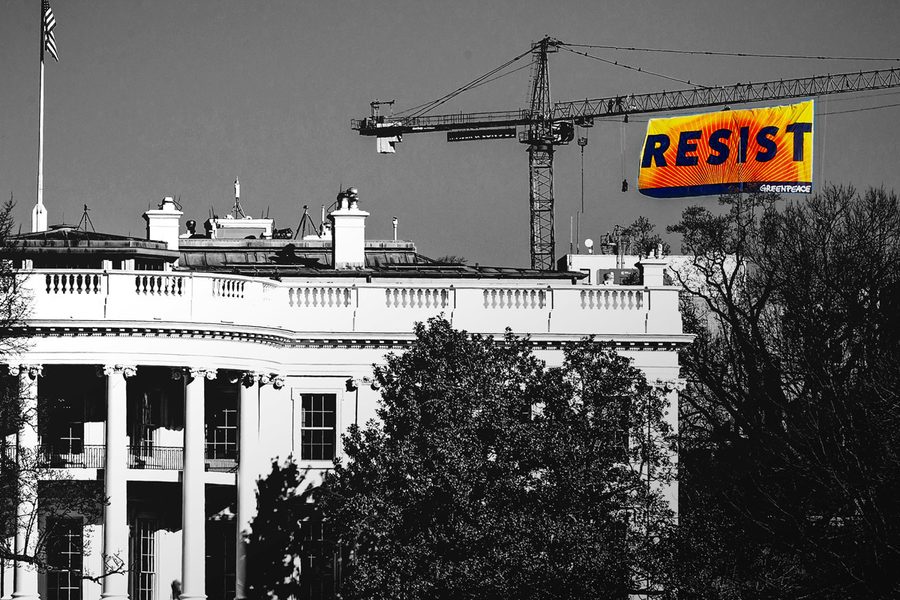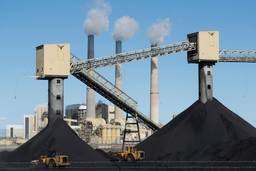The Climate Movement Goes to War with Trump
But to save the planet, we need to remake the Democratic Party
Kate Aronoff

Art Tanderup’s Farm has been busy place these last few years. In 2012, a representative of the oil giant Trans-Canada showed up at his door, offering a handsome check to let the company build a pipeline across his land, which sits atop Nebraska’s Ogallala Aquifer. He said no. Since then, Tanderup Farms has become a base of resistance to the Keystone XL pipeline, hosting everything from a music festival (guests included Willie Nelson and Neil Young) to sacred corn plantings by Ponca elders.
But the mood at the farm has been less than festive since November 8. “As soon as the election was over, we had a feeling,” says Tanderup. “We didn’t know how soon, but we knew [Keystone] was probably on Trump’s agenda.”
Tanderup is speaking with me by phone from his home in Antelope County. We last talked in early 2015, during the height of the fight against the 1,179-mile pipeline extension, which NASA scientist James Hansen has dubbed “the fuse to the biggest carbon bomb on the planet.”
Following years of fierce opposition from Native tribes, climate groups and landowners like Tanderup, the Obama administration rejected permits for Keystone in November 2015, stopping the pipeline in its tracks.
Then Donald Trump arrived at the Oval Office. Just four days after his inauguration, Keystone was back on the table by way of executive memorandum— along with the Dakota Access pipeline (DAPL), halted by the U.S. Army Corps of Engineers late last year.
The first days of the Trump administration can only be described as a full frontal attack on the climate. Within an hour of Trump being sworn in, the new administration scrubbed all mentions of climate change from the White House website. Instead, the site is now home to “An America First Energy Plan,” which promises to repeal Obama’s Climate Action Plan, ramp up oil and gas drilling on public land and revitalize the coal industry.
Then, on February 1, a career oilman, former Exxon Mobil CEO Rex Tillerson, was confirmed as secretary of state, effectively putting U.S. foreign policy in the hands of an industry that threatens civilization as we know it.
Judith LeBlanc, director of the Native Organizers Alliance and a member of the Caddo Nation of Oklahoma, was on the ground in Standing Rock, N.D., when Trump resuscitated the pipelines. She has been a frequent visitor to the encampments that water protectors set up to block DAPL in spring 2016, and she says few there were surprised by the news. “People here,” she told me, “see Trump as a clear and present danger to everyone.”
That same night, organizers around the country staged emergency anti pipeline rallies. The two largest, in Washington, D.C., and New York City, drew thousands of protesters. LeBlanc and others are heartened by these rapid responses. But accompanying protests, she argues, must be a drive to translate grassroots leadership into governing power.
WHAT THE WORLD NEEDS NOW
One thing is clear: A Trump presidency precludes any real hope of decreasing U.S. carbon emissions levels. The task at hand, scientists say, is to rapidly decarbonize the economy and keep some 75 percent of known fossil fuel reserves underground in order to avoid a 2 degree Celsius global temperature rise. Right now, the White House and GOP are moving at breakneck speed in the opposite direction. The planet can’t wait this out for eight years: Trump must go, and soon.
So the climate movement needs to make sure a Democrat defeats Trump in 2020. But even that won’t necessarily be enough. Democrats, unlike their GOP counterparts, clear the low bar of acknowledging that climate change is real. But given the chance, centrist Democrats tend to opt for industry friendly measures like cap and trade, whose complex, technocratic framework leaves plenty of wiggle room for polluters and fails to inspire public enthusiasm. To beat Trump — and stave off climate catastrophe — we need a Democratic Party that eschews the politics of compromise and embraces a low-carbon populism that is unafraid to take on big business.
How do we get the party we need? We build it from the ground up. At the local level, populist platforms animated by a concern for the climate are already winning at the ballot box and changing local and state policies — even in the face of strong oil industry and Republican opposition. This down-ballot insurgency can build the momentum needed for both a fighting Democratic Party and real climate action.
AS GOES ARVIN…
Take the small town of Arvin, Calif., where grassroots environmentalism is already winning elections. In November 2016, the town elected as its mayor 23-year-old Jose Gurrola, who ran on a platform of banning new fracking wells and regulating existing ones. Gurrola defeated two opponents, both Democratic councilmen unwilling to take on the oil and gas industry.
Arvin is fertile ground for this combination of populist and climate-focused politics. Nestled in California’s Central Valley, the town was home to the first migrant laborer housing built as part of the New Deal, immortalized as the Weedpatch Camp in Steinbeck’s The Grapes of Wrath. Today, Arvin is home to just over 20,000 people, many of them undocumented farmworkers. Gas and oil wells dot the town. Because of Kern County’s unique geography — surrounded on three sides by mountains — the toxins spewed out by extraction and agriculture remain trapped in the air above the small city.
As a result, Arvin faces a mounting public health crisis, with air quality oscillating between the worst and second-worst in the nation, depending on the month. Fracking-related flares spout flames and toxic chemicals into the air. Some residents have already been displaced as the result of contaminated water.
In 2015, the Center on Race, Poverty and the Environment (CRPE), a Central Valley environmental justice group, tried to ban fracking in Arvin via a city ordinance. When that failed, CRPE organizer Lupe Martinez and his colleagues realized that the only way to stop industry from pulling the strings of local politics was to elect their own advocate.
Through its electoral arm, the group became the force behind Gurrola’s campaign. Using a texting app borrowed from the Bernie Sanders campaign and going door to door, Gurrola and CRPE staff talked to voters about the air pollution rampant in Arvin and the need for clean energy.
But Gurrola and CRPE also understand that environmental issues can’t be addressed in isolation.
Trump’s embrace of the oil and gas industry represents a clear and present danger to residents of Arvin, but so, too, does his draconian immigration agenda. Arvin is one of 12 towns in California where fewer than half of residents are U.S. citizens, and many are already reporting an uptick in ICE raids since Trump’s inauguration.
“Our communities are so scared of what’s happening nationally,” says Martinez. “We need to take care of the fear first.” For many, he says, the stakes are simple: “If I’ve got a problem with my green card … I can’t help you with the other things you’re doing on methane or on water. It can’t be just one is sue that we’re focused on.”
So as Gurrola works to ban fracking locally, he’s also searching for ways to defend his constituents against deportation. The city has begun drafting a resolution that would limit local police cooperation with federal immigration authorities.
Meanwhile, CRPE is also thinking about how local climate fights can serve as a launchpad to propel grassroots leaders into progressively higher office. “At some point,” says Martinez, “Gurrola is probably going to get the experience to become a [California] assemblyman. And I hope he does … I’m hoping that’s what we’ve started here.” Martinez, who worked for years with the United Farm Workers, also hopes that Gurrola will be the first of many green candidates to run in Kern County.
It’s not hard to imagine this brand of independent politics taking root in other towns like Arvin. A 2014 In These Times investigation found that fracking wells in California are most likely to be situated in low-income communities. That such communities are already bearing the brunt of gas and oil drilling may help explain why a November 2015 Pew poll found that 37 percent of Americans making less than $50,000 annually were concerned that climate change would harm them personally, compared to just 21 percent of those making more than $50,000 a year.
WHAT’S THE MATTER WITH DAVOS?
At last year’s UN climate talks in Morocco, a former climate adviser to the British government issued a prescient warning: “If [mitigating] climate change is labeled as an elitist, global project, which is what UKIP and [Marine] Le Pen want to do, then it’s dead.”
Like the climate crisis itself, Trumpism is a global phenomenon, tied to an uprising against the impacts of neoliberal economic policies that have concentrated global capital in a few hands and left whole countries and communities devastated. Le Pen, Trump and other right-wing populists have successfully cast this as a conflict between a liberal cultural elite and a beleaguered working class, obscuring the role of unfettered capitalism. That Davos regulars like Al Gore, Elon Musk and Leonardo DiCaprio are some of the climate movement’s most recognizable faces should be deeply troubling to anyone invested in a livable future. If climate change is considered a trendy, elite cause, the planet is doomed.
Part of the problem is that even the most passionate of climate activists would be hard-pressed to find an emotional stake in policies like cap and trade, usually negotiated behind closed doors to offer few, if any, benefits to ordinary people. Navigating the path toward a low-carbon future in the era of Trump, then, means giving ordinary people a stake in climate policy, and making it about much more than science.
That’s exactly what People’s Action hopes to do. Rooted in Saul Alinsky style community organizing, the national organization has in recent years adopted climate change and the environment as central issues, alongside local and state efforts to beat back austerity. Making these two fights one and the same has led to the group’s greatest successes, says Jordan Estevao, one of its senior strategists.
In late 2016, for example, People’s Action helped to pass the Illinois Future Energy Jobs Bill — which funds renewable energy, as well as job training and energy efficiency programs targeted at low-income communities — through its two affiliates in the state, Illinois People’s Action and Fair Economy Illinois. Key to doing that, says Estevao, was emphasizing how much these measures could bring down energy bills and drive local economic growth in areas that needed it most.
“Until we’re affirmatively naming how these changes are going to benefit our communities, folks are going to be disinterested, if not opposed,” says Estevao.
A similar measure is now being pushed in New York state by NY Renews, a coalition of labor, climate and racial justice groups aiming to hold Gov. Andrew Cuomo to his promise to act as Trump’s progressive foil.
Campaigns like those in Illinois and New York can pressure Democrats to line up behind progressives’ plans, driving a greater wedge between the party and the GOP. As state-level efforts multiply, they can change the national conversation about what climate action looks like, attracting a diverse group of supporters and dismantling the image of environmentalism as the provenance of elite policy wonks. Designed well, climate legislation can deliver real jobs and savings, posing a tangible alternative to Trump’s fabricated job claims.
In addition to organizing and policy work, People’s Action serves as a leadership pipeline. The program grooms organizers who get involved in its campaigns to run for office, first at the hyperlocal level and then for higher posts.
The Native Organizers Alliance, a People’s Action affiliate, has a similar philosophy. Founded out of the struggle to extend the Affordable Care Act to Indian Country, it has been building up a network of grassroots leaders across Native American communities on a number of fronts, including climate. “There’s a fracturing of the GOP and the Democratic Party,” says Judith LeBlanc, who serves as the alliance’s director. “That opens up opportunities for more independent politics rooted and based on values and issues.”
The kind of politics she envisions is one led by grassroots organizers who possess a deep understanding of how federal and state policies impact their communities.
NEBRASKA’S PARTY CRASHERS
This might look something like the political revolution underway in Nebraska, where pipeline fighters and Sanders Democrats have taken control of their state Democratic Party. Thanks to Sanders’ win in the state’s Democratic caucus in March, his supporters made up the majority of delegates to the party’s June convention. These delegates helped vote a slate of progressive reformers into the party’s top positions.
Jane Kleeb, the new chair of the Nebraska Democratic Party, was a Sanders surrogate during the caucus fight. She now serves on the board of Our Revolution, the official next phase of the Sanders campaign, which works to elect candidates in down-ballot races nationwide. But long before that, she spent four years crisscrossing Nebraska as one of the most visible faces in the state’s fight against Keystone.
After founding the progressive group Bold Nebraska in 2010, the self described “mom in a mini-van” (she and her husband, Scott, have three daughters) embarked on a quest to end what she calls “eminent domain for private gain.” That entailed recruiting ranchers and farmers like Art Tanderup, whose land the pipeline threatened, to join lawsuits aiming to slow or stop the project. Some of these suits are ongoing, she notes, which will mean a lengthy legal process for TransCanada if it wants to continue construction.
“We were able to create this real movement in Nebraska against Keystone XL, not because of the science behind climate change, but because of the emotional tie to the land and water,” says Kleeb.
Kleeb also hopes to use her position at the helm of the state Democratic party to test out a more blue-collar approach to decreasing Nebraska’s carbon emissions. “Democrats should talk about why we need a hard-hat revolution of clean energy — not only to tackle climate change, but to bring steady, good-paying jobs to our rural and urban communities,” she says. “That is a completely different frame than talking about electric cars.”
For example, she hopes to pitch green jobs to the state’s voters as a driver of both economic growth and emissions reductions, with a heavy emphasis on the former. The state party’s platform on energy opposes fracking, fossil fuel subsidies and Keystone while supporting renewables — the near-opposite of Trump’s.
So while the pipeline’s specter once again haunts the heartland, veterans of the fight against it are on stronger footing than ever.
The kind of bottom-up, movement driven politics taking root on Nebraska ranches and California oil fields is antithetical to the way the current Democratic establishment operates. But if the party hopes to stop its slide into oblivion and pose a real challenge to Trump’s right-wing populism, it will have to take its cues from local leaders who are trying a different way of doing things. “This is not a matter of changing messengers in an attempt to recruit people to the same old programs,” says Jordan Estevao. Top Democratic operatives will “have to learn to listen to and follow the leadership of non-elite, diverse working-class people.”
Out of “people who understand the link between movements and policy change,” LeBlanc says, “I think we’re going to see, across the board, more working-class people, people of color and Indians who see this as our time to turn.”
Our last best shot at curbing climate change, in other words, is handing over the reins of the Democratic Party to the people capable of building the kind of low-carbon democracy we need.
Kate Aronoff is a staff writer at The New Republic and author of Overheated: How Capitalism Broke the Planet — And How We Fight Back. She is co-author of A Planet To Win: Why We Need a Green New Deal and co-editor of We Own the Future: Democratic Socialism—American Style. Follow her on Twitter @katearonoff.









